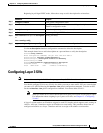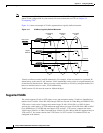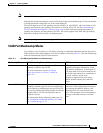
13-2
Catalyst 2960 and 2960-S Switch Software Configuration Guide
OL-8603-09
Chapter 13 Configuring VLANs
Understanding VLANs
Note Before you create VLANs, you must decide whether to use VLAN Trunking Protocol (VTP) to maintain
global VLAN configuration for your network. For more information on VTP, see Chapter 14,
“Configuring VTP.”
Figure 13-1 shows an example of VLANs segmented into logically defined networks.
Figure 13-1 VLANs as Logically Defined Networks
VLANs are often associated with IP subnetworks. For example, all the end stations in a particular IP
subnet belong to the same VLAN. Interface VLAN membership on the switch is assigned manually on
an interface-by-interface basis. When you assign switch interfaces to VLANs by using this method, it is
known as interface-based, or static, VLAN membership.
Traffic between VLANs must be routed or fallback bridged.
Supported VLANs
The switch supports VLANs in VTP client, server, and transparent modes. VLANs are identified by a
number from 1 to 4094. VLAN IDs 1002 through 1005 are reserved for Token Ring and FDDI VLANs.
VTP version 1 and version 2 support only normal-range VLANs (VLAN IDs 1 to 1005). In these
versions, the switch must be in VTP transparent mode when you create VLAN IDs from 1006 to 4094.
Cisco IOS Release 12.2(52)SE and later support VTP version 3. VTP version 3 supports the entire
VLAN range (VLANs 1 to 4094). Extended range VLANs (VLANs 1006 to 4094) are supported only in
VTP version 3. You cannot convert from VTP version 3 to VTP version 2 if extended VLANs are
configured in the domain.
Floor 1
Floor 2
Engineering
VLAN
Cisco router
Gigabit
Ethernet
Floor 3
Marketing
VLAN
Accounting
VLAN
90571


















